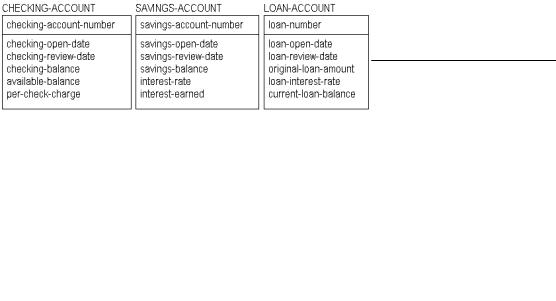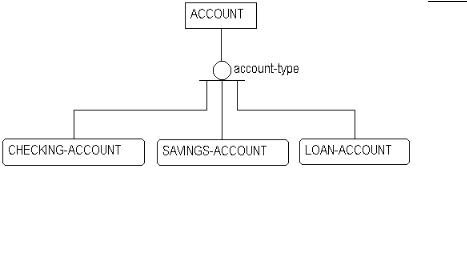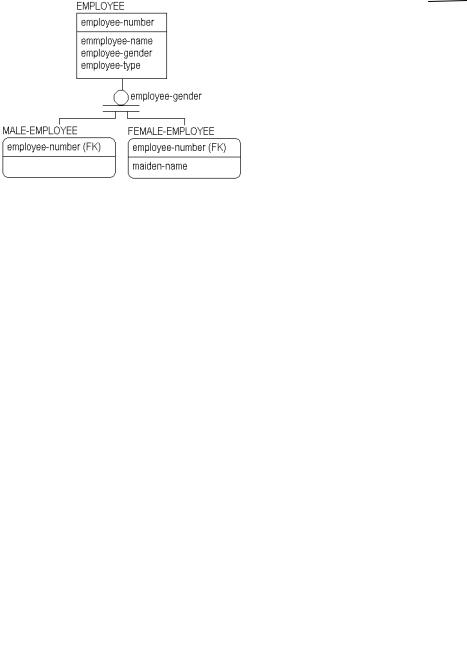
- •Contents
- •Preface
- •Intended Audience
- •About this Guide
- •Typographical Conventions
- •Related Documentation
- •What’s In This Chapter?
- •Chapter Contents
- •What is Data Modeling?
- •Data Modeling Sessions
- •Session Roles
- •Sample IDEF1X Modeling Methodology
- •Logical Models
- •The Entity Relationship Diagram
- •The Key-Based Model
- •The Fully-Attributed (FA) Model
- •Physical Models
- •The Transformation Model
- •The DBMS Model
- •Benefits of Modeling in ERwin
- •What’s In This Chapter?
- •Chapter Contents
- •The Entity-Relationship Diagram
- •Defining Entities and Attributes
- •Logical Relationships
- •Many-to-Many Relationships
- •Validating the Design of the Logical Model
- •Data Model Example
- •What’s In This Chapter?
- •Chapter Contents
- •Understanding Keys
- •Selecting a Primary Key
- •Designating Alternate Key Attributes
- •Inversion Entry Attributes
- •Relationships and Foreign Key Attributes
- •Dependent and Independent Entities
- •Identifying Relationships
- •Non-Identifying Relationships
- •Rolenames
- •What’s In This Chapter?
- •Chapter Contents
- •Naming Entities and Attributes
- •Synonyms, Homonyms and Aliases
- •Entity Definitions
- •Descriptions
- •Business Examples
- •Comments
- •Definition References and Circularity
- •Constructing a Business Glossary
- •Attribute Definitions
- •Rolenames
- •Definitions and Business Rules
- •What’s In This Chapter?
- •Chapter Contents
- •Relationship Cardinality
- •Cardinality in Non-Identifying Relationships
- •Referential Integrity
- •Reading Referential Integrity Options
- •RI, Cardinality, and Identifying Relationships
- •RI, Cardinality, and Non-Identifying Relationships
- •Additional Relationship Types
- •Many-to-Many Relationships
- •N-ary Relationships
- •Recursive Relationships
- •Subtype Relationships
- •Complete Versus Incomplete Subtype Structures
- •Inclusive and Exclusive Relationships
- •IDEF1X and IE Subtype Notation
- •When to Create a Subtype Relationship
- •Introduction
- •Chapter Contents
- •Overview of the Normal Forms
- •Functional Dependence (FD)
- •Full Functional Dependence
- •First Normal Form (1NF)
- •Second Normal Form (2NF)
- •Third Normal Form (3NF)
- •Common Design Problems
- •Repeating Data Groups
- •Multiple Use of the Same Attribute
- •Multiple Occurrences of the Same Fact
- •Conflicting Facts
- •Derived Attributes
- •Missing Information
- •Unification
- •How Much Normalization Is Enough?
- •Conclusions
- •ERwin Support for Normalization
- •First Normal Form Support
- •Second and Third Normal Form Support
- •What’s In This Chapter?
- •Chapter Contents
- •Creating a Physical Model
- •Denormalization
- •Classification of Dependent Entities
- •Glossary of Terms
- •Index
- •Documentation Comments Form

5 |
ERwin Methods Guide |
|
|
Subtype Relationships
A subtype relationship, also referred to as a generalization category, generalization hierarchy, or inheritance hierarchy, is a way to group a set of entities that share common characteristics. For example, we might find during a modeling effort, that several different types of ACCOUNTs exist in a bank, such as checking, savings and loan accounts, as shown below.
Example Account Entities
When you recognize similarities among the different independent entities, you may be able to collect together attributes common to all three types of accounts into a hierarchical structure.
You can move these common attributes into a higher level entity called the supertype entity (or generalization entity). Those that are specific to the individual account types remain in the subtype entities. In the example, you can create a supertype entity called ACCOUNT to represent the information that is common across the three types of accounts. The supertype ACCOUNT includes a primary key of “account-number.”
Three subtype entities, CHECKING-ACCOUNT, SAVINGS-ACCOUNT, and LOAN-ACCOUNT, are added as dependent entities that are related to ACCOUNT using a subtype relationship.
64 ∙ Refining Model Relationships

ERwin Methods Guide |
5 |
|
|
The result is a structure like the one shown below.
Subtype Relationship Example
In this example, an ACCOUNT is either a CHECKING ACCOUNT, a SAVINGS-ACCOUNT, or a LOAN-ACCOUNT. Each subtype entity is an ACCOUNT, and inherits the properties of ACCOUNT. The three different subtype entities of ACCOUNT are mutually exclusive.
In order to distinguish one type of ACCOUNT from another, we add the attribute “account-type” as the subtype discriminator. The subtype discriminator is an attribute of the category supertype (ACCOUNT) and its value will tell us which type of ACCOUNT we have.
Once you have established the subtype relationship, you can examine each attribute in the original model, in turn, to determine if it should remain in the subtype entities, or move to the supertype. For example, each subtype entity has an “open-date.” If the definitions of these three kinds of “open-date” are the same, you can move them to the supertype, and drop them from the subtype entities.
You need to analyze each attribute in turn to determine if it remains in the subtype entity or moves to the supertype. In those cases where a single attribute appears in most, but not all, of the subtype entities, you face a more difficult decision. You can either leave the attribute with the subtype entities, or move the attribute up to the supertype. If this attribute appears in the supertype, this will mean that the value of the attribute in the supertype will be NULL when the attribute is one not included in the corresponding subtype entity.
Refining Model Relationships ∙ 65

5 |
ERwin Methods Guide |
|
|
Which alternative to choose depends on how many of the subtype entities share the common attribute. If most do, it is good practice, at higher level models, to move them up. If few subtype entities share the attribute, it is best to leave them where they are. In lower level models, depending on the purpose, it is often appropriate to leave the attributes in their subtype entity.
After analysis, the resulting model might appear like the one below.
Account Subtype Example
When developing a subtype relationship, you must also be aware of any specific business rules that need to be imposed at the subtype level that are not pertinent to other subtypes of the supertype. For example, LOAN accounts are deleted after they are paid-up. You would hardly like to delete CHECKING and SAVINGS accounts under the same conditions.
There may also be relationships that are meaningful to a single subtype, and not to any other subtype in the hierarchy. The LOAN entity needs to be examined, for example, to ensure that any previous relationships to records of customer payments or assets are not lost because of a different organizational structure.
66 ∙ Refining Model Relationships

ERwin Methods Guide |
5 |
|
|
Complete Versus Incomplete Subtype Structures
In IDEF1X, different symbols are used to specify whether or not the set of subtype entities in a subtype relationship is fully defined. An incomplete subtype indicates that the modeler feels there may be other subtype entities that have not yet been discovered, and is indicated by a single line at the bottom of the subtype symbol.
Incomplete Subtype
A complete subtype indicates that the modeler is certain that all possible subtype entities are included in the subtype structure. For example, a complete subtype could capture information specific to male and female employees, as shown below. A complete subtype is indicated by two lines at the bottom of the subtype symbol.
Complete Subtype
Refining Model Relationships ∙ 67
